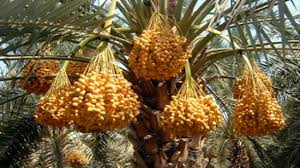KETURA, Israel — When researchers excavated the Masasa fortress in the 1960’s, they found in an underground cistern among other significant archaeological finds some remarkably preserved date pits. The date pits were placed in an archive for some 40 years and almost forgotten -until a fascinating experiment succeeded in rejuvenating them and producing what are arguably the most ancient dates in the world.
Join our WhatsApp groupSubscribe to our Daily Roundup Email
Dr. Sarah Sallon, a pediatric gastroenterologist who directs the Louis L. Borick Natural Medicine Research Center at the Hadassah Hospital in Jerusalem, had heard a lot about the therapeutic properties of dates. Dates are not only beneficial for digestion but are thought by traditional healers to improve blood production and memory, and to have aphrodisiac properties.
The ancient Judean palm was famous for its lush fruits and they are extolled in the Bible as one of the seven fruits for which the land of Israel is renowned. However by the Middle Ages the date palms, ravaged by wars and constant upheavals and needing constant cultivation and watering, died out in Judea. But could they be revived in any way?
Sallon located the ancient date seeds and teamed up with Dr. Elaine Solowey, an expert on arid agriculture who runs the Center for Sustainable Agriculture at the Arava Institute for Environmental Studies at Kibbutz Ketura. The Arava climate, one of the hottest and dryest in Israel is well suited to the growth of date palms.
Solowey planted the seeds in quarantined pots in January 2005, using a few “horticultural tricks,” as she put it, to try to coax them out of their long slumber, including warming, careful hydration, a plant hormone and enzymatic fertilizer.
To her utter astonishment, weeks later a tiny shoot emerged from the ancient seeds which she immediately dubbed Methuselah after the longest-living biblical figure. The shoot grew into a tree proudly situated outside Dr. Soloway’s office.
However Methuselah turned out to be male (gender is determined after flowering) meaning that he cannot bear fruit but could pollinate a female palm tree. Dr. Sallon found 30 more ancient seeds from other archaeological sites in the Judean desert, including Qumran, where the Dead Sea Scrolls were found. Six of the seeds planted at Ketura between 2011 and 2014 sprouted and some of them were females, enabling Dr. Soloway to pollinate them from Methuselah. One of the females, Hannah, recently produced her first harvest of lush,golden-brown dates.
The elated Dr. Sallon joined Dr. Soloway for a special tasting ceremony for the first fruits of the 2000-year-old date seeds they had planted over the past 15 years. A Shehechiyanu bracha was recited and the small gathering tasted the fruits at Kibbutz Ketura last week. The plump brown dates also turned out to be fresh and tasty, belying their grand age.
“In these troubled times of climate change, pollution and species dying out at alarming rates, to bring something back to life from dormancy is so symbolic,” Dr. Sallon told the New York Times. “To pollinate and produce these incredible dates is like a beam of light in a dark time.”
The following I24 news clip was made before the first fruits grew on the new palm trees:


Mazel Tov and Shehechiyanu for Rosh Hashanah.
L’Shanah Tovah !
They should take care to put some pits in a jar and bury it in case the species gets lost again.
what about Orlah
It says clearly in the the article between 2011-2014
So no Orlando issue
Is there any way to prove the authenticity of the year of these seeds are really from?